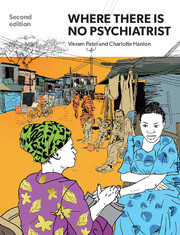Book contents
- Frontmatter
- Contents
- List of contributors
- Preface
- Foreword
- Part 1 An overview of mental health problems
- Part 2 Treatments
- Part 3 Clinical problems
- 6 Emergency management
- 7 Behaviours causing concern
- 8 Symptoms that are medically unexplained
- 9 The person with problems due to habits
- 10 Problems arising from loss and violence
- 11 Problems in childhood and adolescence
- Part 4 Integrating mental health
- Part 5 Localising this manual for your area
- Index
6 - Emergency management
from Part 3 - Clinical problems
Published online by Cambridge University Press: 24 March 2018
- Frontmatter
- Contents
- List of contributors
- Preface
- Foreword
- Part 1 An overview of mental health problems
- Part 2 Treatments
- Part 3 Clinical problems
- 6 Emergency management
- 7 Behaviours causing concern
- 8 Symptoms that are medically unexplained
- 9 The person with problems due to habits
- 10 Problems arising from loss and violence
- 11 Problems in childhood and adolescence
- Part 4 Integrating mental health
- Part 5 Localising this manual for your area
- Index
Summary
This chapter contains 11 flow charts to assist you with assessing and treating the most common mental health emergencies. The first flow chart (6.1) is a master flow chart for acutely disturbed behaviour. By following this flow chart you can work out which of the other flow charts you then need to use for the specific cause of acutely disturbed behaviour (flow charts 6.2 to 6.10).
As you can see from the master flow chart, when a person has acutely disturbed behaviour it is important to first of all check airway, breathing and circulation, and provide immediate resuscitation if needed. The next step is to work out whether the disturbed behaviour has a physical cause (if so, go to flow chart 6.2), or is caused by substance use (intoxication or withdrawal) or poisoning (flow charts 6.4–6.8).
Only after excluding those causes of disturbed behaviour should you start to consider mental health causes. This is the case even if the person has a known mental health problem: you still need to exclude these other causes of disturbance first. If the disturbance is due to a mental health problem, the next step is to decide whether it is related to a mental disorder or disability (e.g. psychosis, mania, dementia, developmental disability) (flow chart 6.9) or is due to mental distress (flow chart 6.10). The last flow chart (6.11) covers the emergency management of a person having a seizure.
Try to learn these emergency flow charts so that they are easier to use in an emergency situation.
After addressing the emergency, you can then refer to other sections of the book (as indicated) for the further non-emergency management of the problem.
These flow charts can be photocopied and displayed in a place where they can be easily seen in an emergency. If you do this, always display the master flow chart (6.1) alongside the other flow charts.
The following symbols were used in the flow charts:
BP, blood pressure
i.m., intramuscular
i.v., intravenous
p.o., orally
p.r., rectally.
- Type
- Chapter
- Information
- Where There Is No PsychiatristA Mental Health Care Manual, pp. 111 - 122Publisher: Royal College of PsychiatristsPrint publication year: 2018
- Creative Commons
- This content is Open Access and distributed under the terms of the Creative Commons Attribution licence CC-BY-NC-ND 4.0 https://creativecommons.org/cclicenses/



